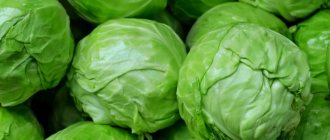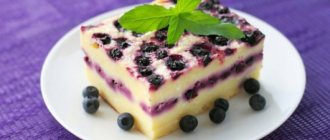Calorie content and properties of rice
Rice is considered one of the basic products in the diet of an expectant mother. The likelihood of developing allergic reactions in a baby is minimal, due to the absence of gluten in this cereal. In rare cases, individual intolerance to the product is observed. However, cereals have a special property, due to which it must be introduced into the diet with caution. The fact is that rice has a strengthening effect on the functioning of the intestines, and if consumed excessively or frequently, it can lead to constipation in mother and baby. It is recommended to adjust the serving size and frequency of intake according to individual needs. If a woman does not observe a negative effect of rice on stool, then it can be included in the daily menu.
Rice belongs to the herbaceous plants of the Cereal family and is very demanding on growing conditions.
This product is rich in vegetable protein, which is easily absorbed by the body. The composition contains vitamins B, PP, E. The rich mineral composition is noteworthy - the cereal contains silicon, phosphorus, iron, manganese, copper, selenium, and zinc in high concentrations. The product contains “slow” carbohydrates, saturates the body for a long time, gives strength and energy.
The calorie content of cereal is about 330 kcal per 100 g, but during the cooking process it absorbs a lot of liquid, increases in volume by 2-3 times, and the energy value of the finished dish is significantly reduced. Thus, boiled rice as a side dish without adding fat contains only about 150 kcal per 100 g. By wisely eating dishes from this cereal, a nursing mother does not have to worry about gaining excess weight.
Table: nutritional value and chemical composition of cereals
| Nutrient | Quantity | Norm* | % of the norm in 100 g |
| Calorie content | 333 kcal | 1684 kcal | 19.8% |
| Squirrels | 7 g | 76 g | 9.2% |
| Fats | 1 g | 60 g | 1.7% |
| Carbohydrates | 74 g | 211 g | 35.1% |
| Alimentary fiber | 3 g | 20 g | 15% |
| Vitamins | |||
| Vitamin B1, thiamine | 0.08 mg | 1.5 mg | 5.3% |
| Vitamin B2, riboflavin | 0.04 mg | 1.8 mg | 2.2% |
| Vitamin B4, choline | 78 mg | 500 mg | 15.6% |
| Vitamin B5, pantothenic | 0.4 mg | 5 mg | 8% |
| Vitamin B6, pyridoxine | 0.2 mg | 2 mg | 10% |
| Vitamin B9, folates | 19 mcg | 400 mcg | 4.8% |
| Vitamin E, alpha tocopherol, TE | 0.4 mg | 15 mg | 2.7% |
| Vitamin H, biotin | 3.5 mcg | 50 mcg | 7% |
| Vitamin RR, NE | 3.3 mg | 20 mg | 16.5% |
| Macronutrients | |||
| Potassium, K | 100 mg | 2500 mg | 4% |
| Calcium, Ca | 8 mg | 1000 mg | 0.8% |
| Silicon, Si | 100 mg | 30 mg | 333.3% |
| Magnesium, Mg | 50 mg | 400 mg | 12.5% |
| Sodium, Na | 12 mg | 1300 mg | 0.9% |
| Sera, S | 46 mg | 1000 mg | 4.6% |
| Phosphorus, Ph | 150 mg | 800 mg | 18.8% |
| Chlorine, Cl | 25 mg | 2300 mg | 1.1% |
| Microelements | |||
| Iron, Fe | 1 mg | 18 mg | 5.6% |
| Yod, I | 1.4 mcg | 150 mcg | 0.9% |
| Cobalt, Co | 1 mcg | 10 mcg | 10% |
| Manganese, Mn | 1.25 mg | 2 mg | 62.5% |
| Copper, Cu | 250 mcg | 1000 mcg | 25% |
| Molybdenum, Mo | 3.4 mcg | 70 mcg | 4.9% |
| Selenium, Se | 15.1 mcg | 55 mcg | 27.5% |
| Fluorine, F | 50 mcg | 4000 mcg | 1.3% |
| Chromium, Cr | 1.7 mcg | 50 mcg | 3.4% |
| Zinc, Zn | 1.42 mg | 12 mg | 11.8% |
| Fatty acid | |||
| Omega-6 fatty acids | 0.19 g | from 4.7 to 16.8 g | 4% |
| Monounsaturated fatty acids | 0.32 g | from 18.8 to 48.8 g | 1.7% |
| Polyunsaturated fatty acids | 0.19 g | from 11.2 to 20.6 g | 1.7% |
Norm* - approximate indicators for a middle-aged nursing mother
Rice porridge as a complementary food

First complementary feeding with rice porridgeThe question of complementary feeding worries new mothers no less than nutrition during breastfeeding. And it is best to know about this process in the first months after the birth of the child. Who knows how feeding will go in the future? But whether it's breastfeeding or formula feeding, at some point the time comes to introduce “real” food.
The safest and healthiest product for this is rice, or rather, well-cooked rice porridge or its water. In general, porridge itself is considered a good way to diversify the children's menu. It is easy to digest and contains a sufficient amount of vitamins, micro- and macroelements. This is the best place to start giving your baby adult food.
When and how much to administer? When breastfeeding, pediatricians recommend starting complementary feeding with rice porridge from 4-6 months, depending on the characteristics of the body. Naturally, this issue must first be discussed with the attending physician and only then decide on complementary feeding. Typically, pediatricians recommend introducing rice porridge into children's menus in the early months if children have low body weight or frequent bowel movements.
Types and their properties
The most common type of rice in our country is Krasnodar round grain polished. It is affordable, sold in any grocery store, and used to prepare dozens of dishes for everyday and holiday menus.
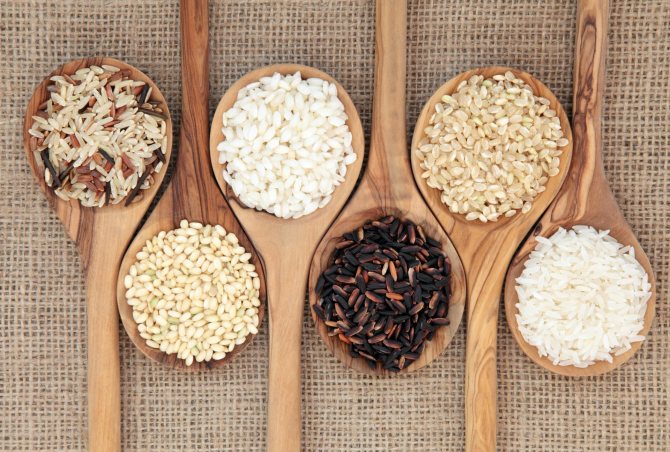
There are more than 150 varieties of rice in the world
However, the classification of rice provides for a variety of species according to various characteristics. Depending on the method of processing in production, it can be:
- Steamed. The grains are subjected to special steam treatment, due to which the rice does not stick together when cooked, and the side dish turns out crumbly. Some of the nutrients are lost.

Parboiled rice is easy to recognize by its appearance - Polished. The grains are cleared of the hard outer shell and have a uniform white color.
- Unpolished. The cereal remains in the shell, which contains more useful components than refined grains. This type of rice is non-white (brown, brown, red, black), takes a long time to cook and has a hard structure.

Unpolished rice takes longer to cook
According to the shape of the grain they are distinguished:
- Round grain. Small round shape - about 4 mm. It contains a lot of starch and acquires a sticky consistency during cooking.
- Long grain. Elongated and large in size - about 6–8 mm. Considered universal, the grains stick together moderately during cooking.
- Medium grain. The grain is medium in size - 5-6 mm, absorbs a lot of liquid during cooking. It has a delicate consistency in the finished dish.
It is better for a nursing mother to choose rice with the lowest level of gluten, for example, brown or steamed. Such cereals are less likely to cause constipation and are lower in calories. But excessive consumption of brown rice can lead to gastrointestinal problems.
The most extensive classification of rice types by variety appears, of which there are more than one hundred and fifty. Each of them differs in its place of growth, size, taste, and density. Most often presented on Russian shelves:
- Krasnodar. Classic rice used for preparing side dishes, cereals, sushi, and desserts. It has a white color and an unexpressed aroma.
- Red rice It has a nutty flavor and a rich vitamin and mineral composition.
- Basmati. Indian variety, often used for preparing pilaf and risotto.

Basmati has long, narrow grains - Wild rice. It is considered the most useful and is black in color. The grains are very hard and difficult to digest, so they are rarely used in their pure form. Basically, it is added to the rice “cocktail” of different varieties of cereals.
- Jasmine. An exotic variety originally from Thailand. The aroma is reminiscent of blooming jasmine.
- Uzbek rice. Long large grains absorb a lot of liquid. When ready, the cereal is crumbly and sweetish in taste. Used to prepare national Uzbek pilaf.
- Arborio. An Italian variety with a delicate consistency. Used for making risotto and soups.
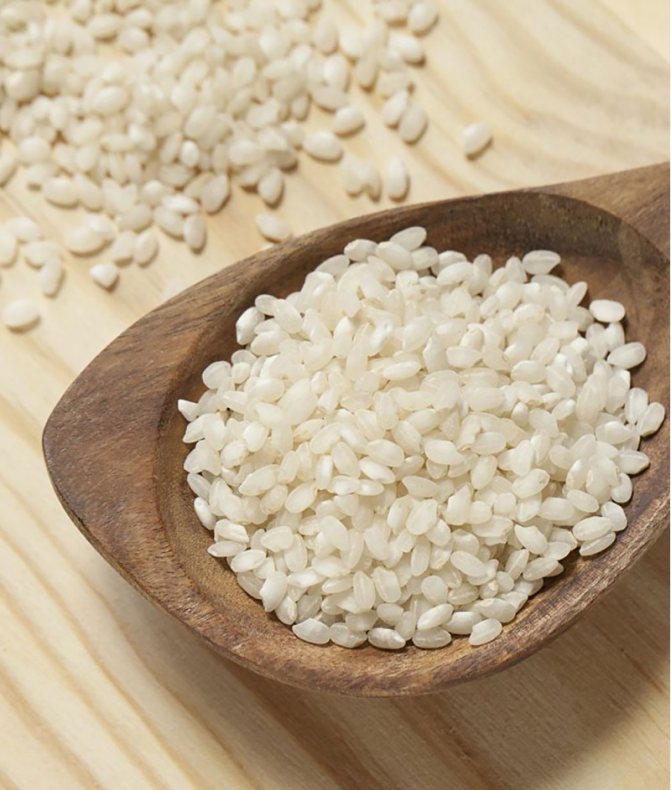
Arborio has a higher gluten level - Camolino. An exquisite variety from Egypt. The grains are round and large, treated with a special oil composition. When cooked, they do not become soft, but become soft and delicate in taste. Used for making porridges, desserts, sushi.
Video: which rice is the healthiest
Which variety is considered the healthiest?
Firstly, rice itself varies in shape (grains can be long, medium, round). Secondly, it may be subjected to heat treatment. Due to different processing methods, rice is divided into:
- Brown. This species does not undergo thorough cleaning. The flower peel is removed from it. He is the most useful. It is in it that all the beneficial properties described above are preserved.
- Parboiled rice (it is yellowish in color). Cleared of the original shell and scales. After cooking, it retains its structure, and also retains up to 80% of its nutrients.
- Classic white rice. It is completely cleaned. Because of this, few nutrients are retained in it. The natural taste of the grain has also been changed. It is not recommended for people suffering from diabetes. Among the advantages: it is most popular in stores and has a low price.
Impact on the body of mother and child
Rice, entering the intestines, acts as an absorbent - absorbs waste and toxins, and then removes them from the body. However, this beneficial property has a downside - along with harmful substances, moisture is also “absorbed” from the intestinal walls, which can sometimes cause constipation. For this reason, rice should be consumed in limited quantities during breastfeeding and monitor the reaction from the digestive system of the woman and the baby.
It is known that the outer shell of rice contains coarse fiber, but this part of the grain is most often removed during processing and grinding of the grains. Rice of brown, brown and other dark varieties retains this beneficial component, which means it is less likely to cause constipation.

It is recommended to consume rice during lactation, following a number of rules
The positive effect of rice during lactation is undeniable and is due to the rich vitamin and mineral composition of the product. Cereals have a beneficial effect on the development of the baby’s brain, promote tissue growth, and strengthen the immunity of mother and child. The most significant components of rice that are beneficial for nursing mothers are:
- Vitamin B4 (choline). It has a beneficial effect on brain activity, memory, and attention. Relevant during postpartum depression, as it helps lift your mood and cope with stress.
- B vitamins. Necessary for the full functioning of the nervous system. Participate in metabolism and regulation of a woman’s hormonal levels.
- Vitamin RR. Necessary to prevent atherosclerosis and the formation of cholesterol plaques. Takes care of blood vessels, supports digestion, regulates blood pressure.
- Silicon. 100 g of rice cereal contains about 300% of the daily value of silicon. This nutrient is necessary for the healing of postpartum sutures, as it promotes skin regeneration. Silicon also lowers cholesterol, stimulates hematopoiesis and improves kidney function.
- Magnesium. Helps take care of the heart and blood vessels, participates in the formation of muscle tissue, and increases stress resistance.
- Phosphorus. Necessary for complete absorption of calcium, strong teeth and bones. Helps improve kidney function.
- Manganese. Participates in lipid metabolism, normalizes the functioning of the central nervous system, promotes the development of bone tissue.
- Copper. Participates in the process of converting iron into hemoglobin, the synthesis of endorphins - good mood hormones. Copper promotes the formation of new cells, including collagen and elastin, in the skin.
- Selenium. Participates in the process of hematopoiesis, has a depressing effect on cancer cells. Selenium stimulates the body's natural defenses, removes heavy metals from the blood, and regulates a woman's hormonal levels.
- Zinc. Promotes tissue regeneration, strengthens hair and nails. Improves attention and memory.
Feedback from nursing mothers
I eat:) I mostly ate pilaf, but I ate it with beets, so that I definitely don’t have to worry about anything :)
Rost-Angeles
https://www.baby.ru/blogs/post/142504070–76979251/
Unfortunately, I succumbed to temptation and ate a couple of servings of rice, I’ve been constipated for 2 days now, my tummy is tormenting ((((I’ll never eat again((
Olga
https://www.babyblog.ru/user/MamulikLena/3008387
I didn’t eat rice at first, but in general, you can eat a small amount in the morning as a test, if the child reacts normally, then increase the dose.
Anyuta Mom♥Sweet♥Baby♥
https://www.baby.ru/blogs/post/105576367–19529138/
Rules and methods for eating rice while breastfeeding
You can try rice for the first time a week after giving birth, if the mother had not previously noticed the obvious strengthening effect of this grain on her body. Please observe the following rules.
- You should start with a small portion - no more than 1-2 tbsp. l. ready rice.
- You need to monitor your own stool and the baby’s reaction to the product. If no digestive problems arise, gradually increase the serving size to 200 g per day.
- If undesirable reactions occur, the product should be excluded from the diet for a month.
- In the first three months of a child’s life, you should not eat rice every day; it is enough to include it in the menu 2-3 times a week.
For the first time, it is recommended to try boiled rice without additional additives to evaluate the baby’s reaction. If there are no signs of food intolerance, move on to complex dishes.

For the first time, you should try regular boiled rice without additives.
Soup
The advantage of this dish is that the liquid and vegetables present in the composition soften the fixing effect of the cereal. You can try soup with rice in the first weeks after giving birth. It is worth considering that the dietary dish is prepared without meat broth and seasonings. Vegetables in the composition are acceptable, but only hypoallergenic ones, for example, potatoes, broccoli, cauliflower, etc.
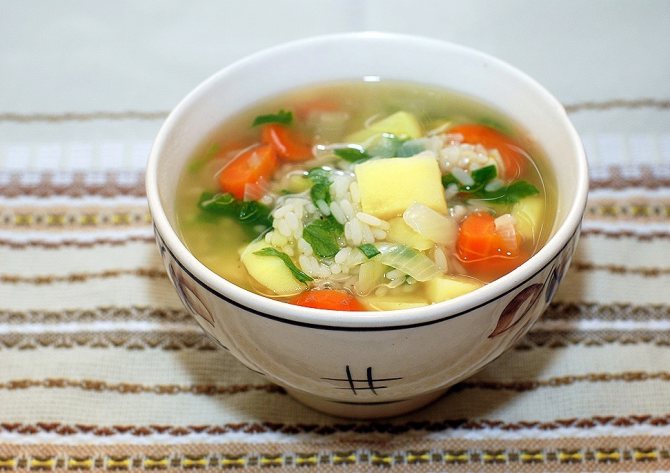
You can only add hypoallergenic vegetables to the soup.
Porridge
An excellent breakfast option for a nursing mother from the first days after childbirth. First, cook the porridge in water. 2–3 months after birth, you can use milk (remember that it is an allergen for the baby), diluting it with water in a 1:1 ratio. When the baby’s digestive system is completely stronger, you can completely switch to milk. It is known that some fruits and dried fruits reduce the fixing properties of rice. So, by adding prunes, pears or bananas to your porridge, you can avoid constipation.

You can add fruit to rice porridge
Boiled rice
Rice can be used as a side dish from the first days of breastfeeding, but introduced into the diet gradually, increasing the serving size every few days. Cook the cereal in a double boiler, slow cooker, or saucepan with water and a little salt. If possible, choose dark varieties (brown, brown, red) or mix them with white rice.
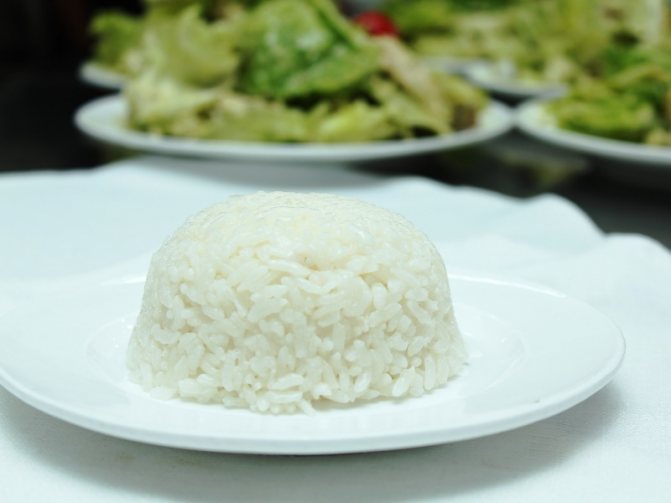
Boiled rice can be an excellent side dish for a nursing mother
Pilaf
This dish requires careful use during breastfeeding. The classic cooking process is not suitable. Fried rice with the addition of a large amount of fat or oil, spices and garlic is contraindicated for mom. If you really want pilaf, then it should be introduced into the diet after the baby’s body is already well acquainted with the rice and vegetable ingredients of the dish separately. If none of the components cause allergies, prepare a dietary version of pilaf. Do not fry vegetables and rice, but simmer them in water. Keep the amount of spices to a minimum. Bay leaves, peppercorns and salt in small quantities are appropriate. But add fresh herbs without restrictions. Consider vegetable risotto as a healthy alternative to traditional meat pilaf.

Diet pilaf is prepared with almost no fat
Photo gallery: rice dishes

A healthy dessert option is rice pudding, which won’t harm your figure.

Pies and casseroles are prepared using rice grains.
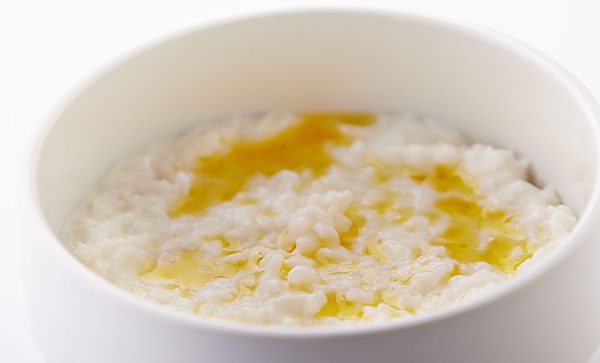
By adding butter to a dish, you will not only improve the taste of rice, but also enrich the composition with additional useful components

During the period of breastfeeding, you can only eat dietary pilaf that does not contain excess fat and spices, cooked with lean varieties of meat.

The side dish of steamed rice turns out crumbly and looks appetizing.
Harm and contraindications of rice porridge

Rice porridge for a newborn Despite the numerous advantages of rice porridge, it can have its drawbacks and be harmful. When breastfeeding, a woman needs to be careful even with ordinary foods. How can rice porridge be harmful?
Firstly, it is very important to observe the measure, and this applies to any vegetable, fruit, type of cereal and other food product. Constipation may occur in both mother and baby when consuming large amounts of rice porridge. Rice strongly binds the intestines, so it can cause problems with bowel movements.
How to select and store
The standard rice grains for preparing a side dish are grains that are snow-white in color, hard but crumbly. For soup and porridge, varieties that boil well and are not pre-treated with steam are suitable. Parboiled rice has a translucent or yellowish tint. The grains never stick together, but absorb a lot of moisture, and the consistency after heat treatment remains dry. For making sushi and meatballs, the best option is round polished rice.

Carefully study the information on the packaging and evaluate the appearance of the rice.
Each housewife has her own preferences regarding the variety and type of rice for creating culinary masterpieces. But when choosing cereals in a store, you should pay attention to the following indicators.
- Date of manufacture. The fresher the rice, the richer its composition, the healthier it is.
- GOST sign. This symbol means that the cereal meets Russian quality standards.
- Size and shape of grains. The grains must be whole, of the same shape and size. There is no need to worry about broken rice, but it is cheaper, and the packaging should indicate that the grain is intended for making porridge.
- Purity. There should be no debris or a large number of dark grains inside the pack.
The shelf life of rice is usually from 1 to 1.5 years, this information should also be indicated on the packaging. It is recommended to store it in a dark, ventilated place in a container that provides air access. These can be plastic or glass containers with leak-proof lids or fabric bags. To avoid the appearance of bugs in the cereal, you can put lemon peels, bay leaves, and garlic cloves inside.
